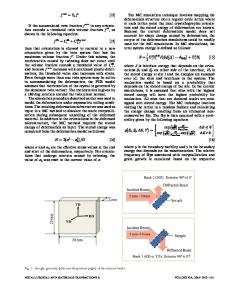Modeling recrystallization kinetics in AA1050 following simulated breakdown rolling
- PDF / 459,415 Bytes
- 11 Pages / 612 x 792 pts (letter) Page_size
- 7 Downloads / 335 Views
HOT working is a process of changing the shape and the microstructure of metals and alloys at elevated temperatures. The important microstructural changes occurring during hot working are recovery and recrystallization, which are the restoration processes that result from the release of the internal energy stored during deformation.[1,2,3] Modeling of thermomechanical processing is well established as a valuable procedure for optimizing processing conditions and is currently the subject of major research efforts in the aluminum industry. Several attempts have been proposed to physically model the recrystallization kinetics.[3,4] These models consider the nucleation positions and growth behavior of the recrystallized grains by linking them to the deformation microstructure through internal state variables. The results have shown that such models describe the experimental results for specific alloys well, though only for uniform processing conditions. However, recent experimental investigations have revealed that the recrystallization is inhomogeneous from grain to grain.[5,6] Such a general characteristic is known to be caused by an inhomogeneous distribution of stored energy. The deformed grains with different orientations have a different stored energy and hence different recovery, nucleation, and growth kinetics. Moreover, the contribution of the recovery on the softening kinetics could be separated using different techniques,[7] and in some cases, this effect is quite large and could not be ignored.[8] It appears that a more sophisticated and fundamental description of the recrystallization should start from considering the microstructure evolution in each single grain. An approach based on such a principle has been proposed by the present authors to predict the recrystallization kinetics after cold deformation in References 9 and 10. In the single grain model, the structure of the deformed alloy is taken into account, which contains the information about the main features of rolled material, i.e., the degree of cold rolling, the grain size, and the grain S.P. CHEN, Research Scientist, is with Corus RD&T, 1970CA, Ijmuiden, The Netherlands. S. VAN DER ZWAAG, Professor, is with the Faculty of Aerospace Engineering, Delft University of Technology, 2629HS Delft, The Netherlands. Contact e-mail: [email protected] Manuscript submitted November 11, 2003. METALLURGICAL AND MATERIALS TRANSACTIONS A
shape. An as-deformed tetrakaidecahedron is applied to describe the grain geometry. The model has been further developed to incorporate both microstructural inhomogeneities and the textural components in the as-deformed state.[10] This is done by relating the stored energy, represented by the subgrain size, to the orientation of the deformed grain and to the degree of deformation. Additionally, recovery is explicitly introduced in the model and its effect on the recrystallization kinetics can be nicely predicted. In this article, the single grain model is further elaborated to predict the recrystallization kinetics follow
Data Loading...











